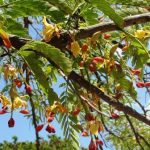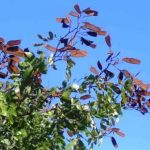TREE LIFE
October 2000
WHILE THE PRESENT PROBLEMS PERSIST PLEASE CHECK WITH ANY OF THE COMMITTEE MEMBERS TO ENSURE THAT THE SCHEDULED OUTINGS AND WALKS WILL ACTUALLY TAKE PLACE.
MASHONALAND CALENDAR
Tuesday 3 October. We will meet Tom in the car park at 4.45 for 5 p.m. and look at the flowering trees or whatever else catches our attention. The cars will be guarded.
Sunday 15 October. A very good venue close to Harare is the Bird Sanctuary and we are grateful to Bird Life Zimbabwe and National Parks for allowing us to use this spot for this month’s outing. Meet at 9.30 a.m.
Saturday 28 October. Mark’s walk will be in the Botanical Garden Extension at Christon Bank.
Tuesday 7 November. Botanic Garden Walk.
MATABELELAND CALENDAR
Sunday 1 October. Lumeni Falls – south Matopos. Meet in the car park of Girls’ College for a prompt departure at 8.30 a.m. In all cases please contact a committee member for confirmation.
Sunday 5 November. Herbst’s farm in the Nyamandhlovu area to look at Sesamothamnus and Commiphora.
BOTANICAL GARDEN WALK September 2000
I am very grateful to Tom for showing us MYRTACEAE and particularly Syzygium on the last Botanic Garden Walk. I did not have my lens so Maureen and I were not able to check to see if there were gland dots in the leaves which I did when I got home. Some did and some didn’t have them. Elsa Pooley mentions them as being present in Syzygium guineense but I have not been able to find any in our Syzygium guineense subsp. guineense. The following notes are a combination of the notes I took during the walk and those I have made subsequently.
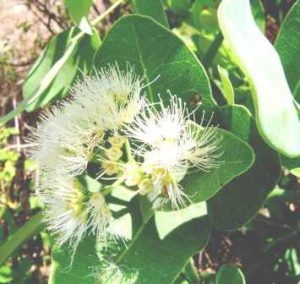
Syzygium cordatum. Photo: Bart Wursten. Source: Flora of Zimbabwe
Syzygium cordatum C. Krause
Occurring along stream banks, in riverine thicket and forest, always near water or along watercourses, and sometimes forming stands of almost pure swamp forest. Leaves usually cordate and sessile.
There is a form with a tapering apex and short petiole up to 6 mm long, but recognizable as this species because of its proximity to water. Tom says he has not been able to grow this successfully in the Botanic Garden although he has one that he claims is a hybrid with subsp.
Syzygium guineense (Willd.) DC. subsp. afromontana F. White
Occurring in sub-montane and dry evergreen forest, on mountains and uplands, in kloof forest, on rocky hills, in riverine habitats and on termite mounds.
Leaves with apex abruptly attenuate e islands.
Keith says it occurs along some of the major rivers in the west, east and south of Zimbabwe, Caprivi, Botswana and northwards. I thought it occurred only along the upper Zambezi but Tom mentioned it on the Hunyani and if the fruit which are large are water-borne one would expect it below and east of Victoria Falls. I must speak to Tom again.
I have since been in touch with John Burrows and he says: “Syzygium guineense subsp. barotsense occurs along the lowveld rivers in the vicinity of Komatipoort here in Mpumalanga. I have heard that it also occurs sporadically through eastern Kruger National Park although I have not seen it there. It certainly is common along the Sabi River in SE Zimbabwe. It is going into the Mpumalanga tree book as subsp. barotsense“.
The bark is markedly pale greyish white, smooth, sometimes buttressed; bank often washed away leaving roots bare and conspicuous: occasionally with aerial roots similar to those produced by Ficus.
Fruit is large, ovoid or ellipsoid, about 3.5 x 2.5 cm, pale white-green at first, becoming flushed with pink and finally reddish purple when mature.
Syzygium guineense (Willd.) DC. subsp. guineense
This is a tree with drooping branches growing in moist places frequently in and fringing vleis, sometimes along river banks and in the ecotone between vleis or streams and woodland and I am proposing to call this the Vlei Waterberry in Zimbabwe. The fruit is small 1-2.5 x 1-2 cm, usually dark purple when mature. With respect to this one John says: “Vlei Waterberry – I don’t know. What we call subsp. guineense in Mpumalanga is not associated with vleis but rather rocky hillsides.”
Syzygium guineense (Willd.) DC. subsp. macrocarpum (Engl.) F. White
This is a small semi-deciduous upright tree up to 11m tall: occurring in miombo woodland, on rocky hills or in dry river beds. The fruit is large, almost spherical, about 3 x 3 cm almost totally white or purple and white in colour. As far as I know, subsp. macrocarpum is not in South Africa and therefore Miombo Waterberry would be perfect as a common name.
I am treating these as full species but as no combinations have been made I am retaining White’s names. I had wondered if some of these, particularly subsp. afromontana F. White and maybe subsp. macrocarpum (Engl.) F. White, might not occur in South Africa but have been overlooked in the past but John does not think so.
Also in Zimbabwe we have Syzygium masukuense (Baker) R.E.Fr.
Occurring at high altitudes, among mountain quartzite crags, or in evergreen forest when it can become dominant.
This is another one which Tom has not been able to grow in the Botanic Garden.
Syzygium owariense (P. Beauv.) Benth.
Occurs in fringing forest always in swampy places at the southernmost limit of its distribution at the Rusitu River and Musapa River at The Corner in the Chimanimani district in eastern Zimbabwe.
And in South Africa there is:
Syzygium gerrardii (Harv. ex Hook.f.) Burtt Davy
Occurring in coastal and evergreen mountain mist-belt forest with a silvery white, bark and conspicuously, buttressed trunk.
Leaves with apex abruptly attenuate ultimately form¬ing a narrowly rounded tip. Fruit ovoid, up to 2 cm long, purplish black when mature.
Syzygium legatii Burtt Davy & Greenway
Occurring in the mist-belt mountain slopes and, kloofs on the Soutpansberg and further south on the Drakensberg escarpment.
Leaves with very fine distinct net-veining on the under surface which separates it from Syzygium gerrardii.
Syzygium pondoense Engl.
Occurring in southern KwaZulu-Natal and adjacent Eastern Cape among Table Mountain Sandstone rocks along riverbanks and on islands in riverbeds often submerged during flooding.
Leaves narrowly elliptic to oblong, (i.e. long and narrow)
Fruit almost round, about 1.5 cm in diameter, red to purple.
I must add that I did have a look in the Herbarium and while specimens of Syzygium guineense subsp. afromontana stood out other species were very difficult to distinguish on leaves alone.
Thanks Tom. Syzygium-wise everything is much clearer now.
-Meg Coates Palgrave
GUN STOCKS AND GUN MAKERS.
(Adapted from an article in WOOD Southern Africa and TIMBER TIMES, February 1999).
With few custom-rifle manufacturers in South Africa, not to mention the rest of the world, the tradition of custom-gun manufacturing lock, stock, and barrel is disappearing.
Modern-day custom-rifle manufacturers tend merely to assemble premanufactured components. Most clients find the practice acceptable when dealing with the metal components of the rifle, but when it comes to the stock, gun lovers are much more discerning.
Finding the right blanks.
It can take up to 120 hours to turn a raw piece of wood, referred to as a blank, into a carefully crafted stock for a rifle or shotgun. The wood for all good blanks has to be imported into South Africa, usually at an astronomical cost, because most South African woods are not hard enough, and those that are, are usually too heavy. The most sought-after imported blanks come from walnut species – Juglans regia (common walnut, from southeast Europe to the Himalayas and China), Juglans nigra (black walnut, from the United States), Juglans neotropica (from Ecuador), and Juglans ailantifolia (from China and Japan). These walnut timbers run out at about 660-670 kg per cubic metre, which is somewhat heavier than our own Mukwa (Pterocarpus angolensis, 640 kg per cubic metre). The nearest equivalent among our figured timbers would be Lovoa swynnertonii (brown mahogany), at 655 kg per cubic metre. The European beech wood has all the necessary strength, weight, and technical characteristics, but it lacks colour and figure. Figure describes the patterns caused by the grain of the wood, and this is what makes the most sought-after blanks so expensive.
The best walnut stocks come from trees that are 200-300 years old, growing in either harsh desert conditions or in snow-covered mountains, where their battles with nature leave the scars that provide them with the desired figure. The best and most expensive stocks come from the root ball, at the junction of roots and trunk. Blanks from the rest of the tree are more affordable. A good blank costs between R4000 and R12000, but if a piece of wood with exceptional figure is wide enough to cut two or more identical blanks out of it, it becomes priceless. Collectors will pay almost anything for a set of three handmade rifles with identical stocks. Production rifles with stocks turned out on copy lathes, and with pressed checkering, may suit just as well, but they do not have the ‘feel’ of classic luxury imparted by a truly custom-made rifle.
Steps in stock making
Blanks are imported into South Africa from America (Juglans nigra), and from Turkey, Morocco, France, and Spain (Juglans regia). The latter species is not indigenous in Morocco, so these blanks must come from planted trees. Once a client has chosen a blank, the laborious task of converting it into a stock begins.
The client’s needs have to be determined, and after taking his or her measurements, the ideal length of the stock is calculated. In rare cases the stock has to be bent to accommodate awkward shooting stances. The gun maker then creates a square plain on the upper side of the chosen blank. A rough layout is done on the blank, and the most important part of this exercise is to determine the position of the action. A mill drill is used for roughly cutting out the bedding for the action and barrel. Then comes the arduous task of chiselling away the wood so that the steel part of the rifle will fit precisely into the stock. To do this, the steel components are blackened over an oil lamp, then pressed into the wood, and the black deposits on the wood indicate where chiselling is needed. The steel must fit tightly into the wood, since even a fraction of a millimetre of play will render the rifle inaccurate, which is why most custom-gun makers also make their own tools for this precision job.
Once the bedding is done a rough outline of the stock is drawn on the wood, and sawn out with a handsaw. The forming is then delicately performed with a wood file or a chisel to define the lines of the stock, and there are a few general rules the stock maker has to adhere to when forming a stock. Lines have to be straight, and curves must be symmetrical and in proportion.
The recoil pad is then fitted, and also a tip if the client wants it, for example a dark wood tip of “black ivory” at the fore end of the stock (black ivory is not listed in any reference book, but possibly refers to Dalbergia melanoxylon). Sanding begins with a rough grade of wet-dry sanding paper, and progresses to finer grades until the stock is smooth enough. The stock is then ‘whisked’, a process of wetting the stock and drying it with quick heat, e.g. from a blow-lamp or a hair drier. When dry, the stock has fine, hair-like fibres standing up on it, and these are sanded down. The process is repeated about three times.
Finishing
Most European clients want a classic, stained ‘London finish’ on their stocks. This comprises a combination of raw linseed oil, turpentine, and alkanet (the red dye obtained from the roots of Alkanna lehmannii [Boraginaceae]). The mixture is heated to just below boiling point and then applied to the stock with a cotton swab or suitable cloth. On porous wood a filler is applied before the oil finish. The oil process is repeated once a day for about 30 days.
After the oil finish the checkering is done with specially made triangular chisels, and to make the task easier the stock is fitted into a checkering cradle, which makes awkward curves more accessible. Getting the right master line is probably the most important part of checkering; this is followed by a series of lines cut parallel to it and then crosscut to form little diamond figures. With the aid of a head-mounted magnifying glass, each diamond is then shaped with a small chisel before applying the checkering oil.
The final product is a precision hand-made rifle that may cost up to ten thousand pounds sterling. When asked why anyone would pay so much for a gun, a gun maker replied, “Life is too short for anyone to want to shoot with ugly guns”.
-Lyn Mullin
ILALA PALMS
The world population of palms comprises about 2800 species. Mainland Africa has only 13 species with seven species confined to the Southern African section. Some years ago I picked up a stack of old African Wildlife magazines from a second-hand book store.
The contents struck me as being far richer in information than anything that was currently going into print in similar periodicals. On reading an article of the palm trees of South Africa I learnt the word cispatose meaning many stemmed or branching and felt very erudite thereafter on the subject of palms of Southern Africa.
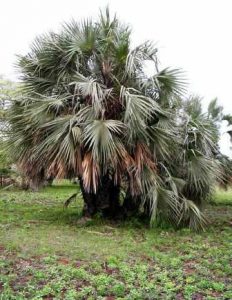
Hyphaene coriacea. Photo: Colin Wenham. Source: Flora of Zimbabwe
The author looked at the palms of Southern Africa in two broad categories, either single stemmed or the cispatose group comprising Phoenix reclinata and the occasional specimen of Hyphaene coriacea (originally Hyphaene natalensis and before that Hyphaene crinita). My particular edition of Coates Palgrave (1977) gets the pictures of the fruit and the text totally mixed up so beware which edition you refer to when identifying these two species. About ten species of Hyphaene are found in the tropics with two species in Southern Africa. The sexes occur on different plants. This is called dioecious. Hyphaene palms have a tap root which is unusual amongst most palm species that only have adventitious roots which in practical terms allow them to transplant with reason¬able ease. Contrary to the Raffia palm of the Mavuradonha Wilderness area, Centenary and Chimanimani area, Hyphaene palms do not die after fruit bearing. This is referred to as pleonanthic behaviour whereas in Raffia the pattern of dying after flowering is called monocarpic behaviour.
Hyphaene coriacea occurs in the Save/Runde junction area of Gonarezhou National Park especially between Tamboharta pan and the Runde River. To my eye, less than two percent of the specimens are branched so it is not a particularly rare sighting to encounter this cispatose feature. The fruit is usually round but some specimens are pear shaped. Both species of Hyphaene have a fibrous pulp covered fruit that tastes a bit like ginger flavoured sawdust which is enjoyed by elephants, monkeys, baboons and possibly rodents. To see an elephant head-butting an Ilala tree with fruit raining down is a very comical sight. Head butting is done with the trunk down and the rustle of the palm fronds high overhead can be heard a long way off but on other occasions they will push the tree holding their trunks fully extended up the stem of the palm and set up a rocking motion of the tree. Fruit take about two years to mature and a further two years to fall to the ground, a little too tardy to placate a pachydermal palate.
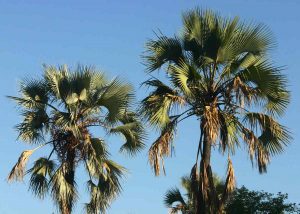
Hyphaene petersiana. Photo: Bart Wursten. Source: Flora of Zimbabwe.
The Ilala palm of the Zambezi River, Hyphaene petersiana , extends into Botswana and Northern Namibia. It is taller than the Southern counterpart but has slightly smaller, round fruit. In the Makgadikgadi NP, I have seen a single specimen that had a branching trunk. On a recent trip I watched local fisherman smoking gutted fish held in place in a longitudinally split branch from a Combretum mossambicense bush with string made from Ilala fronds. The fronds are also used in basket weaving. The kernel often has a hole that forms in it and on another trip to the Okavango we were taking a swim in a watery elephant crossing that was reputed to be free of crocodiles. The river bottom was strewn with old Ilala fruit that must have been voided by crossing elephant over many years. We decided to practice our cricket fielding skills with these old submerged fruit only to discover that these hollow kernels made excellent refuges for leeches! Apparently the strongest elephant or rhino holding pens in game capture operations (bomas) are made of the fibrous stems of the Ilala palm as their elasticity makes them resilient to the insult of irate inmates.
(The Zulu name for the Raffia palm is uMvuma (Tonga= Mvuma). The Raffia palm has the longest leaf at 18 meters, in the plant kingdom. The chimney of the Falcon mine smelter built in 1913 in what was then Umvuma is 40 meters high. This must have been the tallest man made structure at the time in what was then Southern Rhodesia. Is it coincidental that the town with the tallest structure should be called after a plant with the same accolades? According to Encyclopaedia Rhodesia the name is thought to mean thundercloud).
-Karl van Laeren
In Retrospect continues: –
TSHABALALA GAME SANCTUARY
From TREE LIFE No.35 (January 1983) comes a note by Janet Webber on the Tshabalala Game Sanctuary, which was visited by the Matabeleland Branch of the Tree Society in August 1982. Tshabalala Game Sanctuary is situated on the outskirts of Bulawayo on the Matopos Road, in fact its northern boundary borders on the City’s residential area. On the other three boundaries are farms with areas of thick, woody vegetation. It is 1200 ha in extent, with predominantly red soil, although there is an area of black soil, and a few basalt outcrops. It is crossed by the Umganin River and its tributaries, along which can be found several termite mounds, and good cover for bushbuck. The river banks are steep, and their beds form narrow, deep channels whose shallow dams dry up in the winter, so, many waterholes have been provided throughout the park.
It is gradually changing from the mixed farm it once was to a game park, and in the old farmhouse and outbuildings there are bats roosting under the thatch. Even at the time of our original Bird and Tree Society surveys in 1980 the change was apparent, and since then the removal of the cattle and the introduction of game species has caused further modification.
The Tree Society has found 54 species of woody vegetation, and has made a collection of herbaceous plants. The Ornithological Society has listed 65 species [of birds], and each visit brings new entries. The Field Section of the Wildlife Society has carried out a study of the 27 species of grass they found, and estimated their forage values. And the Department of Parks and Wildlife estimates that, with the recent acquisition of eland and Nyala, there are 16 species of grazing and browsing animals in the Park, and there is the possibility one more species being introduced. The carrying capacity of the land is therefore high.
It has been said that “plants are considered the key to the habitat type because they do not move: they are generally the dominant form of life, and they are the food source on which animals depend for their energy”. So, let us look first at the trees.
Trees
Acacias are hardy, drought-resistant trees, and 8 species are found at Tshabalala: in fact, it is the only game park in this country where Acacia is predominant. They are members of the family Fabaceae (Leguminosae), and so have the ability to fix atmospheric nitrogen in their roots, thereby eventually enriching the soil. They provide leaves for browsing animals of all sizes, each eating at its own level, known as trophic levels, giraffe taking the topmost leaves.
Their flowering periods differ, and so cover many months, providing nectar for sunbirds, and, eventually [pods and] seeds for buck, rodents, hornbills, and weevils. I have seen weevils up to 10 mm long in pods of Acacia sieberiana, which, in turn, provide food for insectivorous birds.
[Comment 2000: Not all Acacia species nodulate and fix nitrogen, but those that do occur at Tshabalala are probably all nitrogen-fixing.]A glance at the flowering and fruiting tables in RB Drummond’s book, ‘Common Trees of the Central Watershed Woodlands in Zimbabwe’, shows how trees of one sort or another are flowering and fruiting at all times of the year, thereby providing a continuous source of food for birds, animals, and smaller creatures, such as insects and spiders. They also find refuge in the branches, under the leaves, and in the crevices of the bark. Even the tree parasites, Viscum and Loranthus (mistletoes), so often despised by keen gardeners, are a tremendous source of food for animals and birds, and shelter for louries and doves, which make their nests in them.
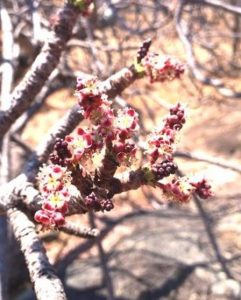
Sclerocarya birrea. Photo: Rob Burrett. Source: Flora of Zimbabwe
Strangely, there are no figs (Ficus spp.) at Tshabalala, but there are many Marula (Sclerocarya birrea) and Ziziphus trees, and also Azanza, Pappea, Cassine, Maytenus, star-berry (Diospyros lycioides), and snowberry (Securinega virosa). Several species of Grewia, Carissa, Rhus, and Pavetta can be found, and there are five species of Combretum. Combretum erythrophyllum grows along the banks of the Umganin, providing high perches for the large birds of prey, as few of the other trees gain much height. Erythrophyllum means red leaves, and refers to the reddish colour they turn in winter before being shed, and the fact that the trees are essentially riverine explains the common name, River Combretum. Peter Steyn comments in The Ostrich on having seen black tits feeding on grubs in Combretum fruits.
[Comment 2000: Cassine species that may be present at Tshabalala have been reclassified into other genera – Cassine aethiopica to Mystroxylon aethiopicum, Cassine matabelica to Elaeodendron matabelicum, Cassine transvaalensis to Elaeodendron transvaalense.]Birds
Tshabalala is great shrike country, and 7 species have been seen there, the most striking being the crimson-breasted shrike, with its glorious contrast of crimson, black, and white. It is said to be independent of water, and thorn-bush is its preferred habitat, which is fortunate for us in Bulawayo, as we sometimes see it in our gardens. Its distribution is in the west through Namibia and Botswana, only just entering the south¬west of Zimbabwe. The Black-cheeked Waxbill has not yet been seen, although it, too, likes thorn-bush, and one would expect it in that area.
Several migratory species have found the park to their liking, such as Wahlberg’s eagle, Yellow-billed Kite, European roller, and the swallow, and there seems to be a suitable niche for every species. There are the river edges for those that like to breed there – such as the golden weaver – and in the non-breeding season birds from the dry areas move in to the river. There are the steep banks for the kingfishers and others to tunnel in, and dead trees for the other hole-nesting birds, such as woodpeckers, barbets, and some kingfishers. Although kingfishers are well known for their fishing ability, some, such as the grey-hooded, the brown-hooded, and the woodland kingfishers are insectivorous.
The attractive Titbabbler, with its chestnut-coloured undertail coverts, has been seen foraging on the ground: crowned plovers and Capped Wheatear are active in the burnt areas, pipits occur on the roads. Francolin and Guineafowl flocks scratch busily for their varied foods, and in January the great spotted cuckoo was seen on the western boundary of the park, searching the lower branches for hairy caterpillars. There is a vacant ecological niche for Oxpecker, but maybe it is only a matter of time for it to be filled. Considering the enterprising experiment carried out in Hwange National Park some time ago, when nooses baited with liver paste were dragged through the bush on the back of a donkey, with most successful results. The oxpeckers thus caught were introduced into the Rhodes Matopos National Park, and have since spread about 30km northwards in the direction of Tshabalala
Grasses
With Acacia trees one finds ‘sweetveld’, i.e. mainly annual grasses palatable for grazing animals, and bearing seed taken by seed-eating birds. In the park there are areas where acacias have been cleared in years gone by, but the sweetveld is still there, at certain times attracting herds of animals, which make a fine sight. Grasses found that have good forage values are: Digitaria, Andropogon, Chloris, Cenchrus, Eragrostis, etc.
In area where wildebeest and zebra occur, when the veld has been well grazed in winter, one can see pink tufts of grass standing up alone in the otherwise short grass. This is an aromatic and unpalatable grass, such as Cymbopogon.
Conclusion
Reference was made at the beginning of this article to the changing nature of Tshabalala. It is a dynamic situation, and changes will take place all the time. Seeds may have been brought from other regions when the animals were translocated, and, with all sorts of other life from far and wide, may still be being brought in by for example, the migratory birds and the vehicles of visitors.
In his On the Origin of Species, Darwin wrote over 100 years ago:
It is interesting to contemplate a tangle of plants of many kinds, with birds singing in the bushes, the various insects flitting about and with worms crawling through the damp earth, and to reflect that these elaborately constructed forms, so different from each other, and dependent upon each other in so complex a manner, have all been produced by laws acting around us.
At Tshabalala you are permitted to walk about the veld, and can reflect on these interactions.
In Retrospect will continue next month
-Lyn Mullin
ANDY MACNAUGHTAN CHAIRMAN


